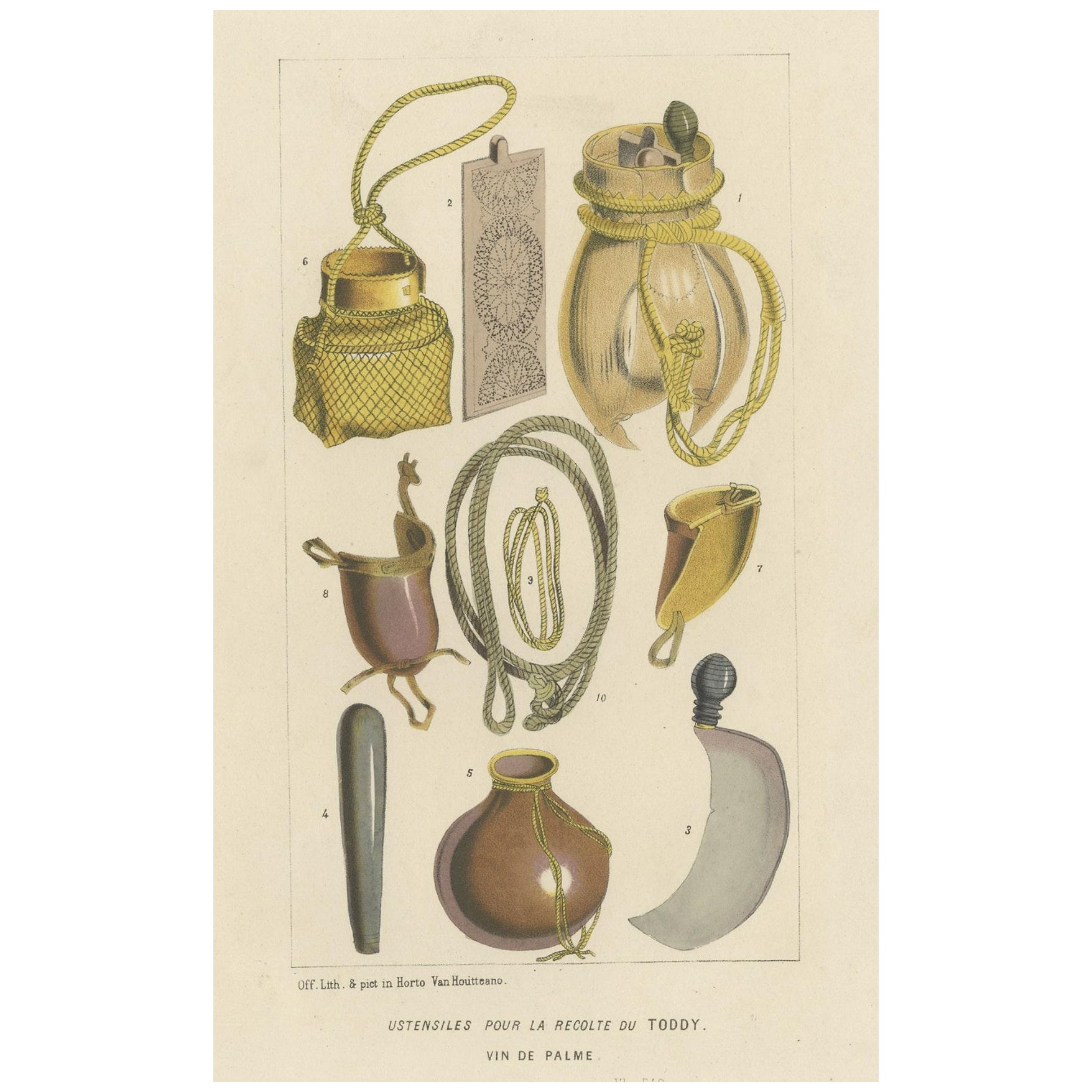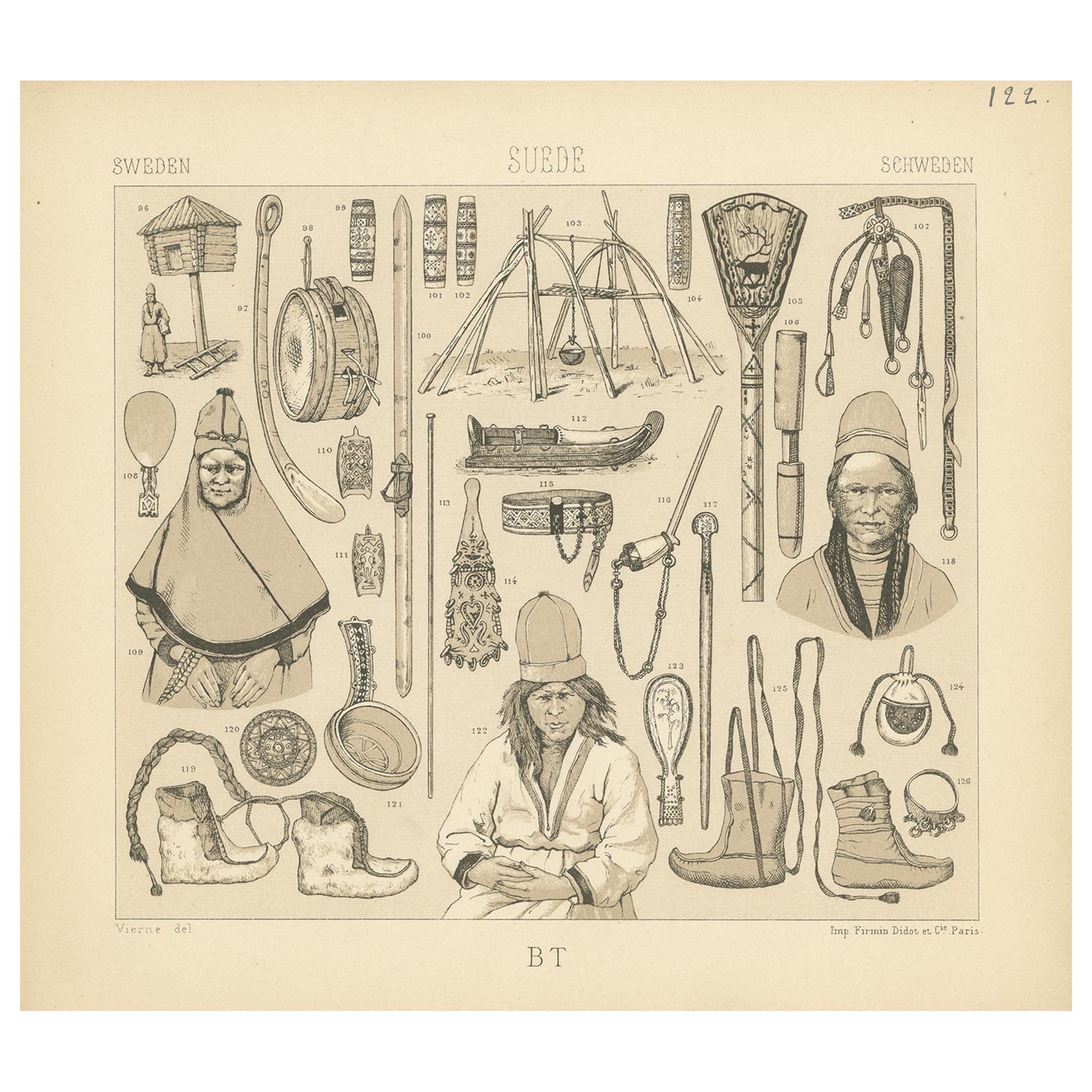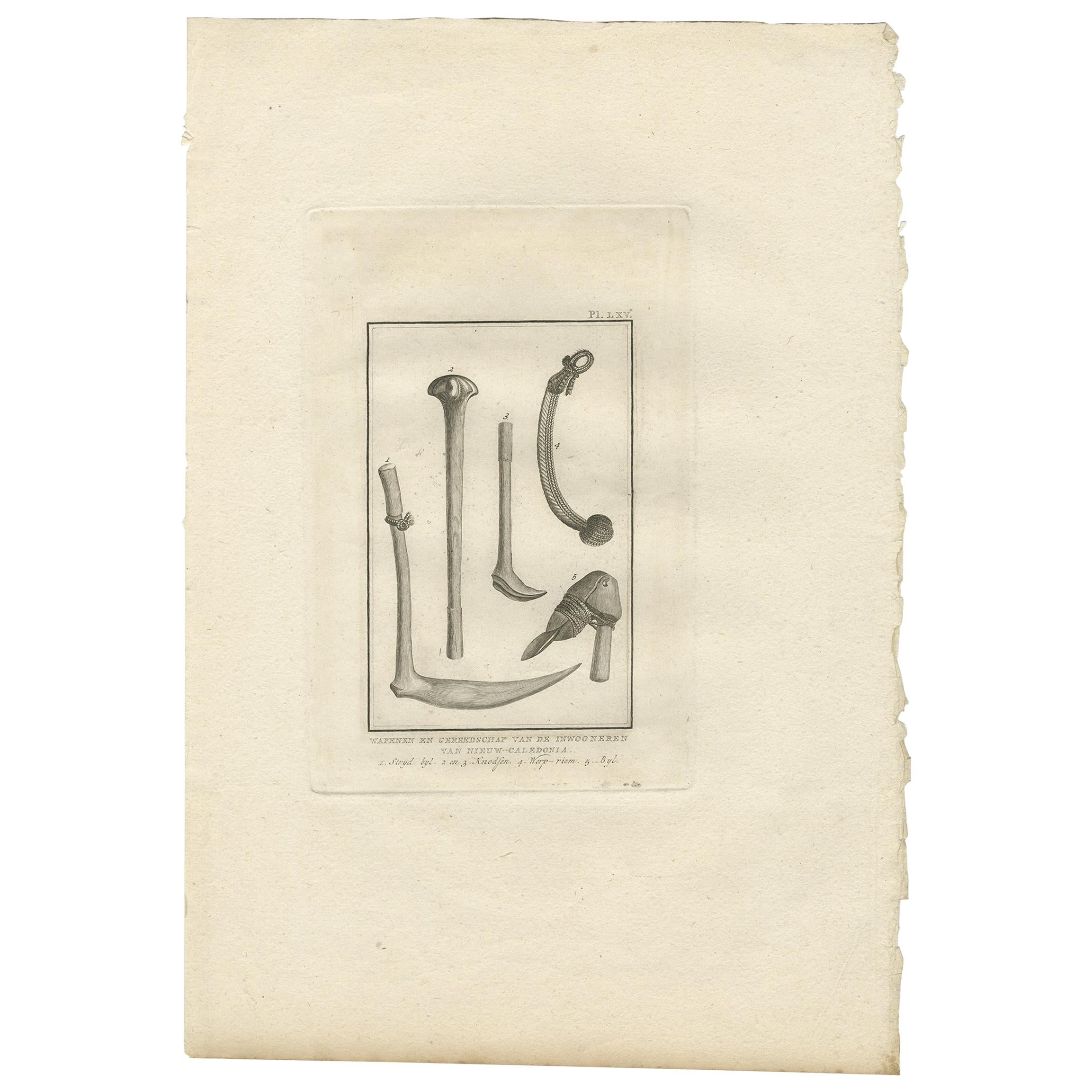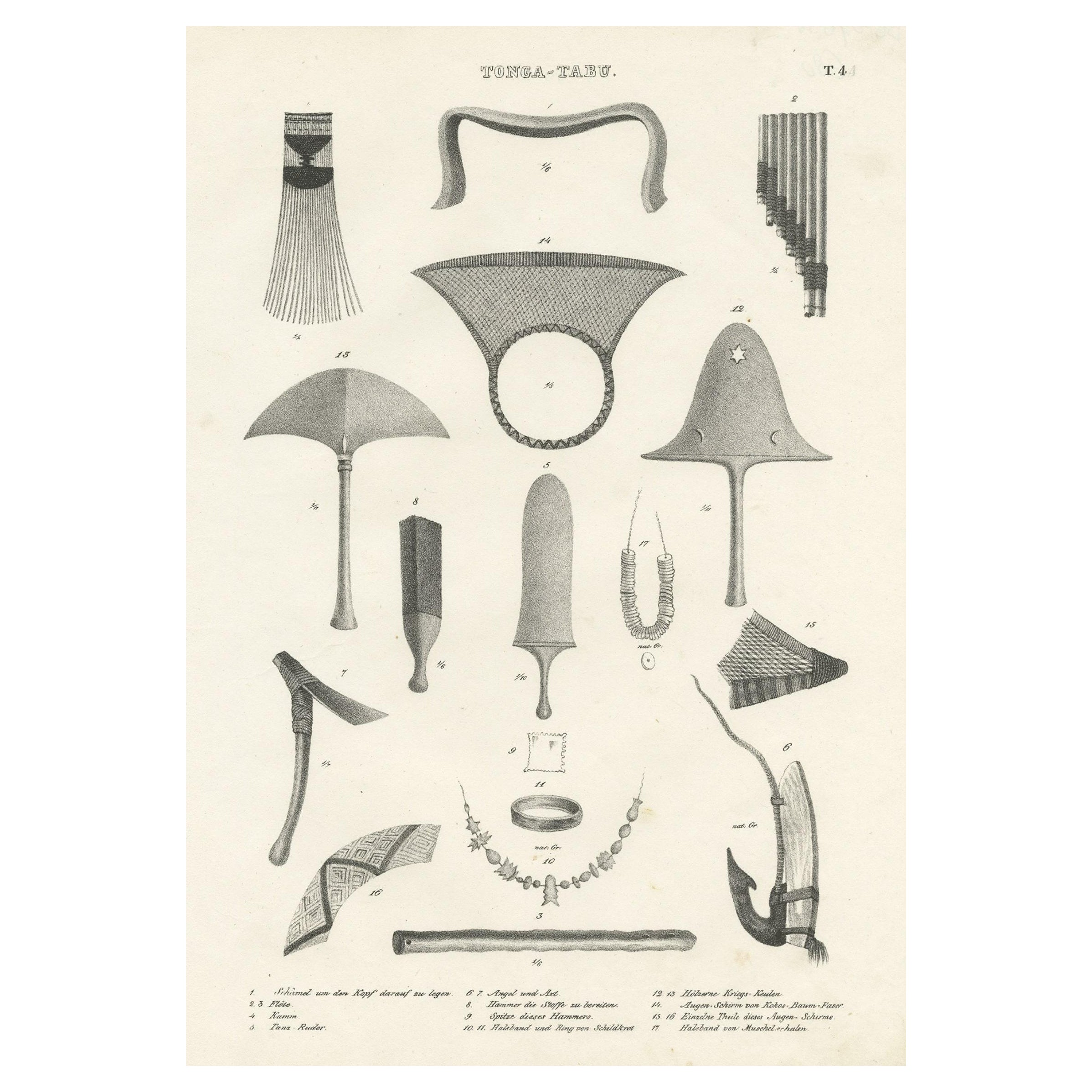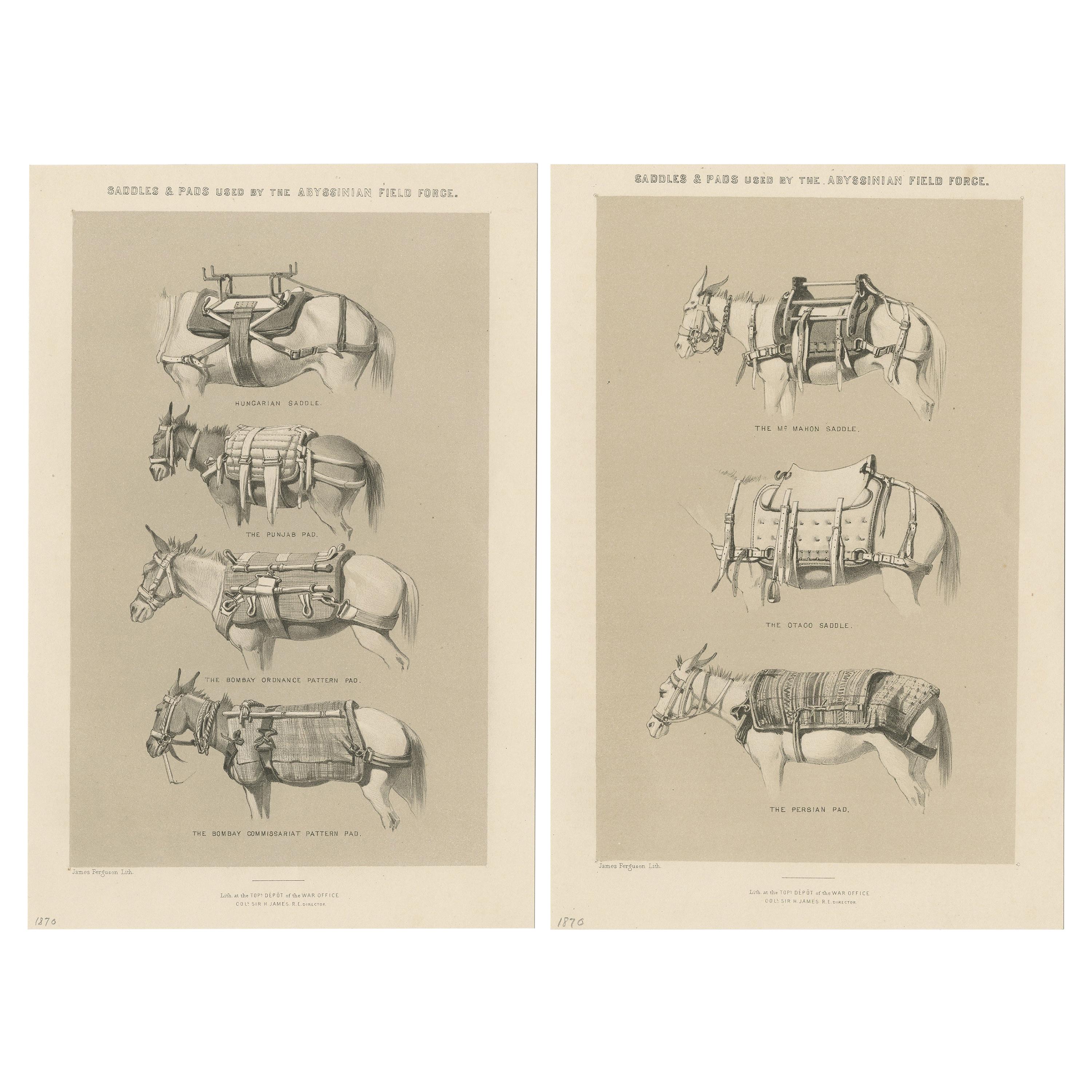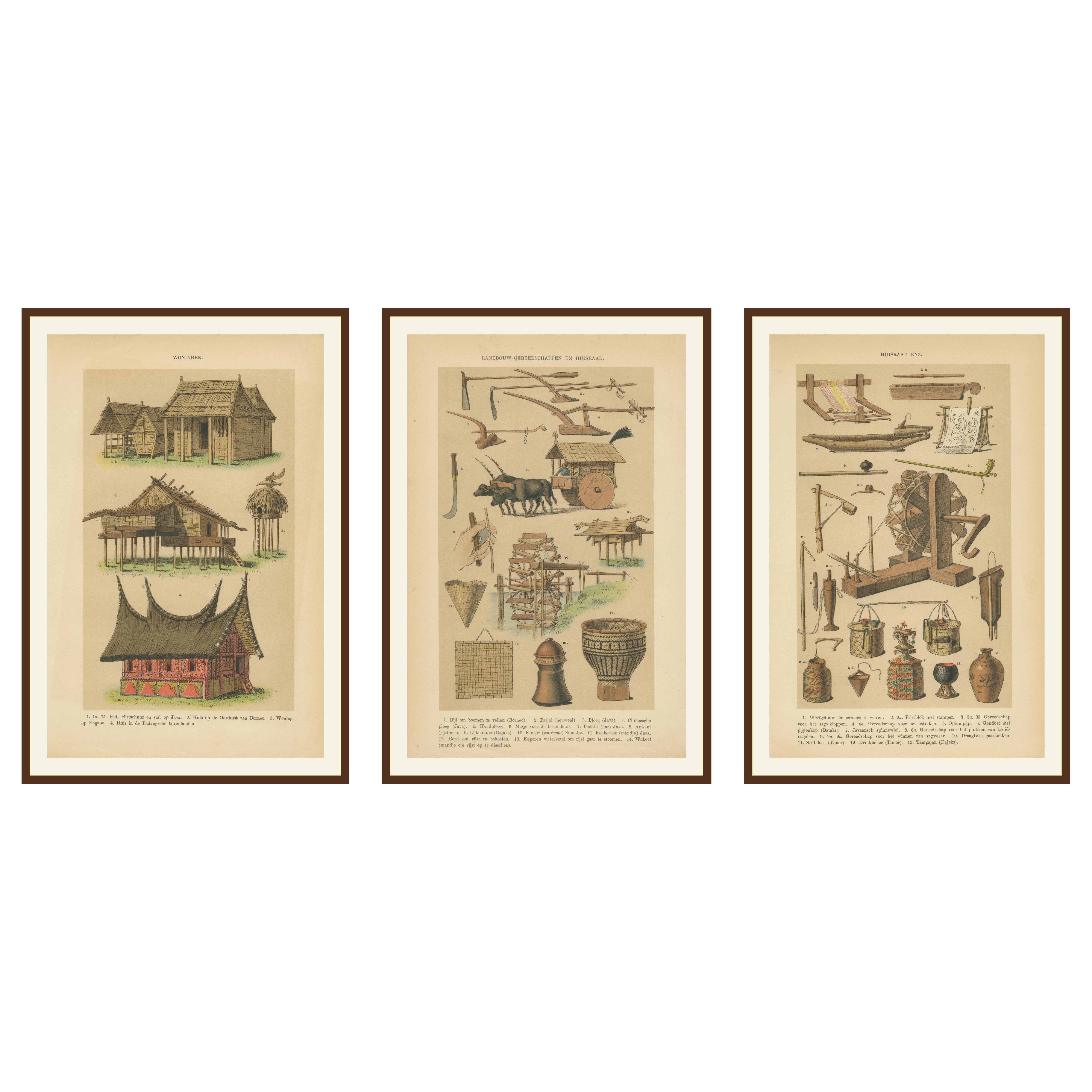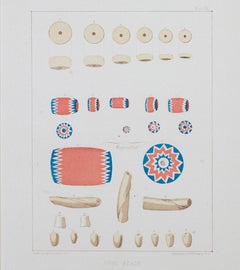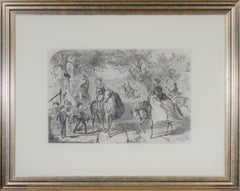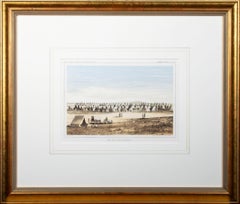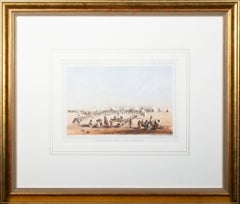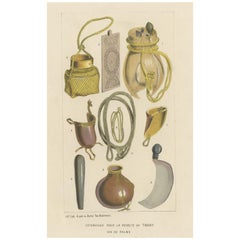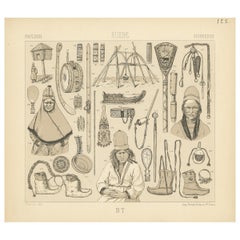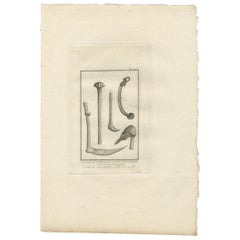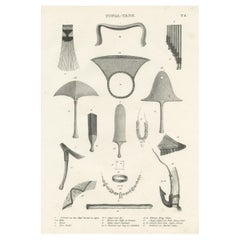Items Similar to 'Birchbark Sap Buckets and Yoke' original halftone print, Bureau of Ethnology
Want more images or videos?
Request additional images or videos from the seller
1 of 7
Unknown'Birchbark Sap Buckets and Yoke' original halftone print, Bureau of Ethnology1896
1896
$550
£411.20
€473.33
CA$771.60
A$840.28
CHF 441.52
MX$10,264.70
NOK 5,483.93
SEK 5,185.80
DKK 3,533.28
About the Item
This halftone print was included in the 1898 report of the Bureau of Ethnology to the Smithsonain Institution. The sap buckets and yoke are from the Menominee tribe, and the text of the book describes how the buckets were fashioned and folded from birch bark, how the yoke is now in the National Museum, and then goes on to describe the processes the Menominee use to make syrup.
5.5 x 7.5 inches, image
15.5 x 18 inches, frame
Inscribed "Bureau of Ethnology" upper left
Inscribed "Fourteenth Annual Report PL XXXII" upper right
Inscribed "Birchbark Sap Buckets and Yoke" bottom center
Framed to conservation standards using archival materials including 100 percent rag french matting, UV5 Plexiglas to inhibit fading, and housed in a cherry-finish wood moulding.
Powell, J.W. 'Fourteenth Annual Report of the Bureau of Ethnology to the Secretary of the Smithsoanin Institution 1892-93. Part 1.' Washington: Government Printing Office, 1896, 287-290, illus. 284-285.
- Creation Year:1896
- Dimensions:Height: 15.5 in (39.37 cm)Width: 18 in (45.72 cm)
- Medium:
- Movement & Style:
- Period:
- Condition:
- Gallery Location:Milwaukee, WI
- Reference Number:Seller: 10796g1stDibs: LU60536497192
About the Seller
4.9
Platinum Seller
Premium sellers with a 4.7+ rating and 24-hour response times
Established in 1966
1stDibs seller since 2017
444 sales on 1stDibs
Typical response time: 2 hours
- ShippingRetrieving quote...Shipping from: Milwaukee, WI
- Return Policy
Authenticity Guarantee
In the unlikely event there’s an issue with an item’s authenticity, contact us within 1 year for a full refund. DetailsMoney-Back Guarantee
If your item is not as described, is damaged in transit, or does not arrive, contact us within 7 days for a full refund. Details24-Hour Cancellation
You have a 24-hour grace period in which to reconsider your purchase, with no questions asked.Vetted Professional Sellers
Our world-class sellers must adhere to strict standards for service and quality, maintaining the integrity of our listings.Price-Match Guarantee
If you find that a seller listed the same item for a lower price elsewhere, we’ll match it.Trusted Global Delivery
Our best-in-class carrier network provides specialized shipping options worldwide, including custom delivery.More From This Seller
View All"Coin Beads--Western US Wilderness Expedition, " Color Lithograph by Seth Eastman
By Seth Eastman
Located in Milwaukee, WI
"Coin Beads - Western US Wilderness Expedition of 1847" is a color lithograph by Seth Eastman. It depicts various Native American beads used as currency and...
Category
1840s More Prints
Materials
Lithograph
19th century woodcut engraving print figurative American forest trees scene
By Winslow Homer
Located in Milwaukee, WI
The present woodcut engraving is an original print designed by Winslow Homer, originally published in Harper's Weekly on April 30, 1859. It is an excellent example of the many prints Homer produced of fashionable people engaged in leisurely activities, in this case along a picturesque countryside lane. The sign reading 'Belmont' on the left indicates this is probably near his home in Belmont Massachusetts. The image presents multiple figures, both men and women, riding horseback: Some in the distance gallop away, toward a town marked by a church steeple beyond. Three others in the foreground, including two equestrian women, gather around a group of children who have been gathering flowers and trapping birds...
Category
1850s Victorian Figurative Prints
Materials
Woodcut, Engraving
'Camp Red River Hunters' original lithograph by John Mix Stanley
By John Mix Stanley
Located in Milwaukee, WI
In the mid-nineteenth century, the United States government set out to survey and document its newly acquired lands and territories west of the Mississippi. The goals of these surveys were manifold: to produce topographical maps, to document flora and fauna, and to document natural resources to build the emerging US economy. These surveys, and the images from them, also functioned to build the new sense of American identity with the landscape, condensing vistas into the 'picturesque' tradition of European image making. Thus, the entire span of US territory could be seen as a single, cohesive whole.
This lithograph comes from one of six surveys commissioned by the Army's Topographic Bureau in 1853, which sought to find the best route to construct a transcontinental railroad. The result was a thirteen-volume report including maps, lithographs, and technical data entitled 'Explorations and Surveys to ascertain the most practicable and economical route for a Railroad from the Mississippi river to the Pacific Ocean.' In particular, the print comes from the northern survey, commanded by Isaac Stevens, which explored the regions between the 47th and 49th parallels.
In this image, Stanley shows an encampment of the people known as the Red River of the North hunters. They were generations of European and mixed-race trappers who lived on the frontier and had Indian wives and mixed-race children. They had come to the area for bison hunting, as the herds were still vast on the prairies. In the image, the figures and their encampment are dwarfed by the vast landscape around them, indicating the sublimity of these new American territories.
5.75 x 8.75 inches, image
6.5 x 9.25 inches, stone
17 x 20 inches, frame
Artist 'Stanley Del.' lower left
Entitled 'Camp Red River Hunters' lower center margin
Publisher 'Sarony, Major & Knapp. Lith.s 449 Broadway N.Y.' lower right
Inscribed 'U.S.P.R.R. EXP. & SURVEYS — 47th & 49th PARALLELS' upper left
Inscribed 'GENERAL REPORT — PLATE XII' upper right
Framed to conservation standards using 100 percent rag matting with French accents; glazed with UV5 Plexiglas to inhibit fading; housed in a gold reverse ogee moulding.
Print in overall good condition; some localized foxing and discoloration; minor surface abrasions to frame.
John Mix Stanley...
Category
1850s Romantic Landscape Prints
Materials
Lithograph
'Distribution of Goods to the Assiniboines' original John Mix Stanley lithograph
By John Mix Stanley
Located in Milwaukee, WI
In the mid-nineteenth century, the United States government set out to survey and document its newly acquired lands and territories west of the Mississippi. The goals of these surveys were manifold: to produce topographical maps, to document flora and fauna, and to document natural resources to build the emerging US economy. These surveys, and the images from them, also functioned to build the new sense of American identity with the landscape, condensing vistas into the 'picturesque' tradition of European image making. Thus, the entire span of US territory could be seen as a single, cohesive whole.
This lithograph comes from one of six surveys commissioned by the Army's Topographic Bureau in 1853, which sought to find the best route to construct a transcontinental railroad. The result was a thirteen-volume report including maps, lithographs, and technical data entitled 'Explorations and Surveys to ascertain the most practicable and economical route for a Railroad from the Mississippi river to the Pacific Ocean.'
When it came to depicting the Assiniboine people, as seen in the present print, Stanley chose to juxtapose their encampment, marked by tipis in the distance, with the encampment of the Isaac Stevens survey party. In the foreground, commemorating this moment, Isaac Stevens can be seen presenting trade goods, which are known to include thirty two dressed skins and two robes. The survey leader Isaac Stevens noted being grateful for the generosity of the Assiniboine, commenting: "I felt very grateful indeed to those Indians, for their kindness to my men, their proffer of kind feeling and hospitality to myself and the survey." This description and this image, however, are arguably depicted through rose-colored glasses: to the Assiniboine people, this meeting may well have included stressful diplomatic relationships and have indicated a threat to the sovereignty over the territories agreed to be theirs by the 1851 Treaty of Fort Laramie.
5.75 x 8.75 inches, image
6.5 x 9.25 inches, stone
17 x 19.75 inches, frame
Artist 'Stanley Del.' lower left
Entitled 'Distribution of Goods to the Assiniboines' lower center margin
Publisher 'Sarony, Major & Knapp. Lith.s 449 Broadway N.Y.' lower right
Inscribed 'U.S.P.R.R. EXP. & SURVEYS — 47th & 49th PARALLELS' upper left
Inscribed 'GENERAL REPORT — PLATE XIV' upper right
Framed to conservation standards using 100 percent rag matting with French accents; glazed with UV5 Plexiglas to inhibit fading; housed in a gold reverse ogee moulding.
Print in overall good condition; some localized foxing and discoloration; frame in excellent condition.
John Mix Stanley...
Category
1850s Romantic Landscape Prints
Materials
Lithograph
'Near Mrs. Teshmakers, Edmonton' original etching by John Thomas Smith
By John Thomas Smith
Located in Milwaukee, WI
The present is one of the many prints John Thomas Smith produced of English cottages and vernacular architecture. This example, a view of a cottage in Edmonton, is closely related to...
Category
1790s Old Masters Landscape Prints
Materials
Paper, Etching
"Camanche Inscription on the Shoulder Blade of a Buffalo, " after S. Eastman
By Seth Eastman
Located in Milwaukee, WI
"Camanche Inscription on the Shoulder Blade of a Buffalo" is a lithograph after an original drawing by Seth Eastman. It depicts Native American inscriptions on an animal bone. It was...
Category
1850s Animal Prints
Materials
Lithograph
You May Also Like
Antique Lithograph of Utensils to Harvest Palm Wine or Toddy, 1851
Located in Langweer, NL
Description: Antique print titled 'Ustensiles pour la Recolte du Toddy'.
Lithograph of utenstils to harvest palm wine (or toddy). This print originates from 'Flore des serres et des jardins...
Category
Antique 1850s Prints
Materials
Paper
$154 Sale Price
20% Off
Pl. 122 Antique Print of Swedish Tools of Racinet, 'circa 1880'
Located in Langweer, NL
Antique print titled 'Sweden - Suede - Schweden'. Chromolithograph of Swedish Tools. This print originates from 'Le Costume Historique' by M.A. Racinet. Published, circa 1880.
Category
Antique Late 19th Century Prints
Materials
Paper
$96 Sale Price
20% Off
Antique Print of Tools from New Caledonia by Cook '1803'
Located in Langweer, NL
Antique print titled 'Wapenen en Gereedschap van de Inwooneren van Nieuw-Caledonia'. This print depicts various weapons and tools of New Caledonia. Origi...
Category
Antique Early 19th Century Dutch Prints
Materials
Paper
$193 Sale Price
20% Off
Old Print Depicting Various Utensils of Tongatabu, Site of Tonga's Capital, 1836
Located in Langweer, NL
Antique print titled 'Tonga-Tabu'.
Tongatapu is the main island of the Kingdom of Tonga and site of Tonga’s capital, Nuku?alofa. It is located in Tonga's southern island group, t...
Category
Antique 1830s Prints
Materials
Paper
$309 Sale Price
20% Off
Set of Two Antique Prints of Saddles and Pads Used by the Field Force, 1870
Located in Langweer, NL
Antique print titled 'Saddles & Pads used by the Abyssinian Field Force'. Set of two lithographs of saddles and pads used by the Abysinnian Field Force. This print originates from 'R...
Category
Antique Mid-19th Century Prints
Materials
Paper
$145 Sale Price / set
20% Off
Antique Javanese Prints – Houses, Farming Tools & Household Utensils – c.1860
Located in Langweer, NL
Antique Javanese Prints – Houses, Farming Tools & Household Utensils – c.1860
This striking set of three finely hand-colored lithographs documents aspects of daily life and material...
Category
Antique Mid-19th Century Dutch Prints
Materials
Paper
More Ways To Browse
Antique Yoke
Antique Yokes
Powell Antique
Antique Sap Bucket
Ryan Hewett
S L Margolies
Salvador Dali Bull
Salvador Dali Fallen Angel
Salvador Dali Fashion Designer
Salvador Dali Hamlet
Salvador Dali Jesus On The Cross
Salvador Dali Judah
Salvador Dali Paradise 6
Salvador Dali Paradise Lost
Salvador Dali Purgatory 1
Salvador Dali Self Portrait
Salvador Dali Signature
Salvador Dali Signed Paradise
